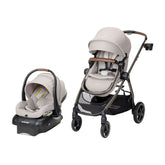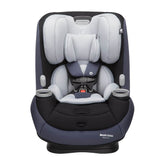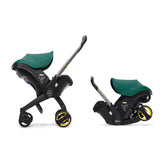When Will My Baby Start Sitting Up & How Can I Help?

One of the most exciting developmental milestones for parents is when their baby sits up on their own. It marks a significant step towards independence and opens up a whole new world of exploration for the child. However, every baby is different, and the age at which they sit up can vary widely.
When Will My Baby Start Sitting Up? What Age Should a Baby Start Sitting Up?
Typically, babies begin to sit up on their own between 4 and 7 months of age. However, some babies may start as early as 3 months, while others may not sit up until 9 months or later. There are many factors that can influence when a baby sits up, including their individual physical development, muscle strength, and coordination.
Can I Put My 3-Month Old Baby in a Sitting Position?
One of the first signs that a baby is ready to sit up is when they can hold their head up steadily. This usually happens around 3 to 4 months of age. As their neck muscles strengthen, they will be able to lift their head higher and for longer periods of time. This is an important step towards sitting up, as it helps the baby to maintain their balance.
Around 5 months of age, babies may begin to roll over from their tummy to their back and from their back to their tummy. This is another important developmental milestone that indicates that they are building strength in their core muscles. As their core muscles get stronger, they will be better able to sit up with support.
At around 6 months of age, many babies will be able to sit up with support. This means that they can sit upright when placed in a supportive chair or propped up with pillows or cushions. They may also be able to sit up briefly without support, but they will likely still need assistance to maintain their balance.
The Bumbo Floor Seat provides contoured support to help your baby sit upright during feeding or active playtime. This "baby sit up chair" is soft, comfortable, and easy to clean.

When Will My Baby Sit Up on Their Own?
By 7 to 9 months of age, most babies will be able to sit up on their own without support. They will have developed enough strength in their core muscles and improved their coordination and balance to maintain a seated position. They may still topple over occasionally, but they will quickly learn how to catch themselves and sit up again. Like other milestones, there’s a wide range of normal, but if your little one still isn’t able to sit on their own by this age, it’s a good idea to bring it up with your pediatrician.
How Can I Help My Baby Learn to Sit Up?
Most infants can sit with help between 4 and 5 months old, either with a little support from a caregiver or a seat or by supporting themselves on their hands, but it definitely differs from child to child. At this stage of development, most infants’ heads are reasonably stable and won’t tilt backward when placed in a seated position.
Once your baby is able to hold their head up well, you can begin propping them up to give them an interesting new viewpoint from which to observe their surroundings. Here are a few ways you can help encourage them:
Prop up your baby in the stroller and go for a walk.
Sitting vertically is a whole new vantage point for an infant! Stroll around the neighborhood so that your little one can watch all the amazing new sights. Point out things you see along the way, like flowers, trees, or other children.
Provide your baby with support and a cushion.
Infants are wobbly for a little while, but practice makes perfect! The more your little one gets to exercise those muscles for sitting, the more likely they are to try it unassisted. Keep your baby on a blanket or activity mat to soften any falls and stay nearby so that you can catch them if they tumble over. Seat your infant on your lap or between your legs on the floor. You can read to them, sing funny songs, and play different movement games, like “timber” onto a soft quilt.
Spend lots of time on the floor.
Try to get in lots of floor play with age-appropriate toys, at least two or three times per day. This may help foster more independence than simply putting your baby in an infant seat. Stay close by and let your baby have plenty of trial-and-error practice exploring and experimenting with different techniques and their own body movements.
Use toys for motivation.
Put one near your baby’s toes while they’re sitting up. They may try to prop themselves up to play with it. You may also try getting their attention first by showing them a toy near their feet, then lifting it to eye level. Your little one might reach for it while sitting, possibly staying seated all by themselves while playing with it. Toys that engage play in this position include activity cubes, ring stackers, shape sorters, and soft blocks.

When to Worry If Baby Is Not Sitting Up
It’s important to go to all your baby’s routine wellness checks so your pediatrician can monitor their development and growth. If your infant is at least 9 months old and you’re still wondering, “When will my baby be able to sit up?” it may be time to have a discussion with the doctor. Signs of developmental delays differ from child to child, but it could be an indication of a gross motor skill delay. Other potential signals of motor delay may include:
- inflexible or tense muscles
- limp, droopy movements
- baby shows a preference for reaching with only one hand instead of the other
- absence of strong neck and head control
- baby not reaching for or bringing objects to their mouth
If you think your baby may have a developmental delay, help is available. Start by talking with your child’s doctor or nurse. They may direct you to services for infants and young children, like your state’s public early intervention program. You can also find information online on the Centers for Disease Control and Prevention (CDC) website or, in the United States, by calling 800-CDC-INFO (800-232-4636).
The Takeaway on When Baby Should Start Sitting Up
Sitting up is a significant developmental milestone for babies, and it's exciting to watch them reach it. Most babies will begin to sit up with support around 6 months of age and be able to sit up on their own by 7 to 9 months of age. However, every baby is different, and it's important to focus on your baby's individual progress and not compare them to other babies. Enjoy watching your little one grow and reach new milestones!
Disclaimer: The information on our site is NOT medical advice for any specific person or condition. It is only meant as general information. Please contact your health provider if you have any medical questions or concerns about your child or yourself.









